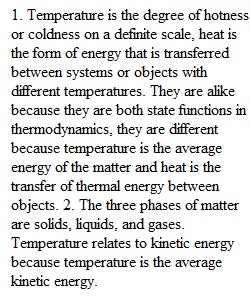


Q This assignment aligns with the following Unit Objectives: • (U55) Define and distinguish between heat and temperature. (CLO2)(CLO3) • (U56) Express temperature using Fahrenheit, Celsius, and Kelvin scales. (CLO2)(CLO5) • (U60) Define and calculate specific heat and latent heat. (CLO2)(CLO3)(CLO5) • (U58) Discuss heat transfer applications and relate them to phase changes of matter. (CLO2)(CLO3) • (U59) Define methods of heat transfer: conduction, convection, radiation. (CLO2)(CLO3) • (U61) Explain and apply the laws of thermodynamics (CLO1)(CLO2)(CLO3)(CLO5) • (UDS) Develop a well thought out and correct response to various discussion questions (CLO2)(CLO3)(CLO5)(Goal 4) Do not start a new thread. Simply reply to my posting. Be sure to comment on at least two of your classmates' postings. Your replies must be more than a simple phrase like "I agree" or "I like your answers". Replies should reflect why you agree or like what has been posted. Your replies must reflect a genuine effort to engage your fellow classmates regarding the comments provided or the problem that has been solved. Please post your answers and replies to the discussion questions below 1. Define temperature? What is heat? How are they alike and different? 2. What are the three phases of matter? How does temperature relate to kinetic energy? Which phase of water has more kinetic energy? Explain your answer. 3. What is the difference in temperature between the freezing point of water and the normal boiling point of water on the Fahrenheit, Celsius scale and on the Kelvin scale? Explain how you figured this out. 4. Define Specific Heat and Latent Heat. Give examples of phenomena that involve each type of heat.
View Related Questions